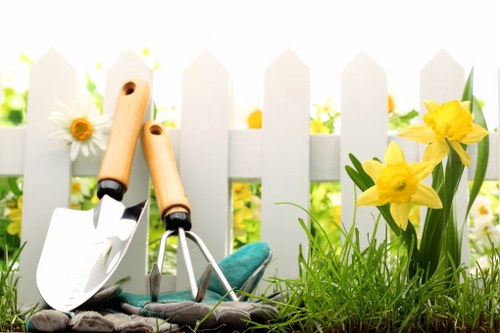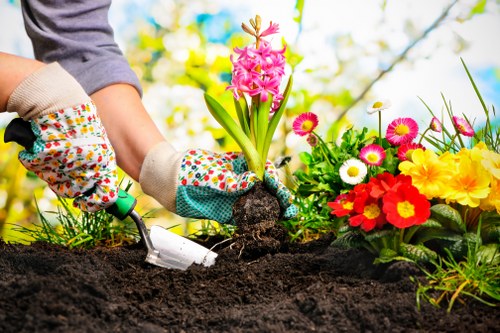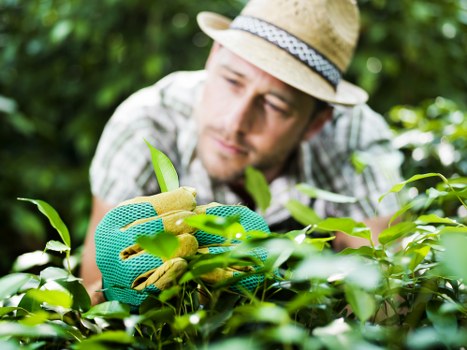Gardeners in Landscape Gardening: Crafting Beautiful Outdoor Spaces
Introduction to Landscape Gardening

Landscape gardening is an art and science that involves the design, creation, and maintenance of outdoor spaces to enhance their aesthetic appeal and functionality. At the heart of this transformative process are gardeners in landscape gardening, skilled professionals who bring visions to life by blending nature with design principles.
These gardeners possess a deep understanding of plant varieties, soil health, and environmental factors, enabling them to create harmonious landscapes that thrive year-round. Whether it's a serene backyard retreat or a sprawling public park, landscape gardeners play a crucial role in shaping our outdoor environments.
In this article, we'll explore the various aspects of landscape gardening, the essential skills gardeners bring to the table, and how you can collaborate with them to create stunning outdoor spaces.
The Role of Gardeners in Landscape Gardening

Gardeners in landscape gardening are not just plant enthusiasts; they are designers, planners, and caretakers all rolled into one. Their responsibilities encompass a wide range of tasks, from selecting the right plants to ensuring that the landscape remains healthy and vibrant over time.
One of the primary roles of landscape gardeners is to assess the site conditions, including soil quality, sunlight exposure, and climate factors. This assessment helps in selecting suitable plant species that will thrive in the given environment. Additionally, they consider the client's preferences and the functional requirements of the space, whether it's for relaxation, recreation, or aesthetic purposes.
Beyond plant selection, gardeners also design hardscape elements such as pathways, patios, and water features. These structural components complement the greenery and add texture and interest to the landscape. By integrating both natural and built elements, gardeners create balanced and inviting outdoor areas.
Essential Skills of Landscape Gardeners

Successful landscape gardeners possess a diverse set of skills that enable them to tackle various challenges in garden design and maintenance. Here are some of the key skills that set them apart:
- Plant Knowledge: Understanding different plant species, their growth patterns, and care requirements is fundamental.
- Design Acumen: Ability to create aesthetically pleasing and functional layouts that meet the client's needs.
- Soil Management: Expertise in improving soil health through composting, mulching, and proper irrigation techniques.
- Problem-Solving: Addressing issues like pests, diseases, and environmental stressors effectively.
- Project Management: Planning and executing projects within budget and timeframe constraints.
These skills ensure that gardeners can deliver landscapes that are not only beautiful but also sustainable and easy to maintain.
Design Principles in Landscape Gardening

Effective landscape gardening relies on several design principles that guide the creation of cohesive and appealing outdoor spaces. Some of these principles include:
- Balance: Achieving a sense of equilibrium through the distribution of visual weight, whether symmetrical or asymmetrical.
- Unity: Ensuring that all elements in the landscape work together harmoniously.
- Contrast: Using varying colors, textures, and shapes to add interest and depth.
- Focal Points: Creating areas of interest that draw the eye and provide visual anchors.
- Scale and Proportion: Maintaining appropriate sizes and relationships between different landscape elements.
By adhering to these principles, gardeners can create landscapes that are both functional and visually stunning.
Plant Selection and Placement

One of the most critical aspects of landscape gardening is selecting the right plants for the space. Gardeners consider various factors such as climate, soil type, light exposure, and water availability when choosing plants. They aim to create a biodiversity-rich environment that supports local ecosystems while also meeting aesthetic goals.
Proper plant placement is equally important. Taller plants are often positioned at the back or center of a garden bed, while shorter species fill in the gaps. This layering technique not only creates depth but also ensures that each plant receives the appropriate amount of sunlight and space to grow.
Additionally, gardeners incorporate a mix of perennial and annual plants to provide year-round interest. Perennials offer long-term structure, while annuals bring vibrant colors and seasonal changes to the landscape.
Soil Health and Maintenance

Healthy soil is the foundation of any successful landscape. Gardeners implement various techniques to maintain and improve soil quality, ensuring that plants have the nutrients they need to thrive. Practices include:
- Composting: Recycling organic waste into nutrient-rich compost to enrich the soil.
- Mulching: Applying a layer of organic or inorganic material to conserve moisture, suppress weeds, and regulate soil temperature.
- Irrigation Management: Installing efficient watering systems and scheduling to prevent over or under-watering.
- Soil Testing: Analyzing soil composition to determine pH levels and nutrient deficiencies, allowing for targeted amendments.
By prioritizing soil health, gardeners create resilient landscapes that can withstand environmental stresses and reduce the need for excessive maintenance.
Incorporating Sustainable Practices

Sustainability is a key consideration in modern landscape gardening. Gardeners strive to create eco-friendly landscapes that minimize environmental impact while promoting biodiversity and conservation. Here are some sustainable practices commonly employed:
- Native Plant Usage: Selecting plants native to the region reduces water usage and supports local wildlife.
- Rainwater Harvesting: Collecting and using rainwater for irrigation to conserve water resources.
- Organic Gardening: Avoiding chemical fertilizers and pesticides in favor of natural alternatives.
- Energy-Efficient Lighting: Using solar-powered or LED lighting to reduce energy consumption.
- Habitat Creation: Designing gardens that provide shelter and food for beneficial insects and wildlife.
These practices not only benefit the environment but also create healthier and more resilient landscapes.
Hardscape Elements in Landscape Design

Hardscape features, such as patios, pathways, and walls, play a significant role in landscape gardening by adding structure and functionality to outdoor spaces. Gardeners carefully select materials and designs that complement the natural surroundings and meet the needs of the space.
For example, stone pathways can guide visitors through the garden, while wooden decks provide areas for relaxation and socializing. Water features like fountains or ponds add a sense of tranquility and can serve as focal points within the landscape.
Integrating hardscape elements with softscape (plant life) creates a balanced environment where both natural and man-made features enhance each other.
Seasonal Landscaping: Year-Round Beauty

Maintaining a landscape that remains attractive throughout the year requires careful planning and selection of plants that offer seasonal interest. Gardeners incorporate a variety of species that bloom, change color, or provide texture in different seasons.
- Spring: Bulbs like tulips and daffodils bring vibrant colors after winter.
- Summer: Lush greenery and flowers such as roses and lavender create a lively atmosphere.
- Autumn: Plants with colorful foliage like maples and oaks add warmth and depth.
- Winter: Evergreens and ornamental grasses provide structure and interest even in the cold months.
By designing for each season, gardeners ensure that the landscape remains engaging and beautiful all year long.
Garden Maintenance and Care

Once a landscape is established, ongoing maintenance is essential to preserve its health and appearance. Gardeners provide regular care through tasks such as pruning, weeding, fertilizing, and pest control.
Pruning helps maintain plant shape and encourages healthy growth, while weeding prevents unwanted plants from competing with desirable species. Fertilizing ensures that plants receive the necessary nutrients, and integrated pest management techniques keep pest populations in check without harming beneficial insects.
Additionally, gardeners monitor the landscape for signs of stress or disease, addressing issues promptly to prevent larger problems. Regular maintenance not only keeps the garden looking its best but also extends the lifespan of the landscape features.
The Benefits of Hiring Professional Gardeners

Engaging professional landscape gardeners offers numerous advantages for homeowners and businesses alike. Here are some key benefits:
- Expertise: Professionals bring specialized knowledge and skills to design and maintenance tasks.
- Time-Saving: Hiring gardeners frees up your time, allowing you to enjoy your outdoor space without the hassle of managing it.
- Customized Designs: Gardeners tailor their services to meet your specific preferences and requirements.
- Increased Property Value: A well-maintained landscape can enhance the curb appeal and value of your property.
- Sustainability: Professionals implement eco-friendly practices that benefit both your garden and the environment.
Investing in professional gardening services ensures that your landscape is both beautiful and sustainable.
Collaborating with Your Landscape Gardener

To achieve the best results, effective collaboration with your landscape gardener is essential. Here are some tips for working together:
- Clear Communication: Clearly articulate your vision, preferences, and any specific requirements you have for the space.
- Set Realistic Goals: Understand the limitations of your property and work with the gardener to set achievable objectives.
- Budget Planning: Discuss your budget upfront and prioritize elements that are most important to you.
- Regular Updates: Maintain open lines of communication throughout the project to stay informed about progress and any potential adjustments.
- Feedback: Provide constructive feedback to ensure that the final outcome aligns with your expectations.
By fostering a collaborative relationship, you and your gardener can create a landscape that truly reflects your vision.
Trends in Landscape Gardening

Landscape gardening is continually evolving, with new trends emerging that reflect changing preferences and advances in sustainability. Some current trends include:
- Vertical Gardening: Maximizing space by growing plants vertically using structures like trellises and green walls.
- Edible Gardens: Integrating vegetables, herbs, and fruit trees into ornamental landscapes for a functional and beautiful space.
- Drought-Tolerant Plants: Choosing species that require minimal water to promote conservation and reduce maintenance.
- Outdoor Living Spaces: Creating areas for dining, lounging, and entertaining to extend living spaces outdoors.
- Smart Irrigation Systems: Utilizing technology to optimize watering schedules and conserve water.
Staying informed about these trends can help you make informed decisions when designing or updating your landscape.
Conclusion

Gardeners in landscape gardening are instrumental in creating and maintaining beautiful, functional, and sustainable outdoor spaces. Their expertise in plant selection, design principles, soil health, and maintenance ensures that landscapes not only look stunning but also thrive over time.
Whether you're looking to transform your backyard, enhance your property's curb appeal, or design a public park, collaborating with professional landscape gardeners can help you achieve your goals. Their commitment to quality and sustainability makes them valuable partners in crafting spaces that you can enjoy for years to come.
Contact us today to begin your journey towards a breathtaking landscape tailored to your unique vision and needs. Let our experienced gardeners turn your outdoor dreams into reality.